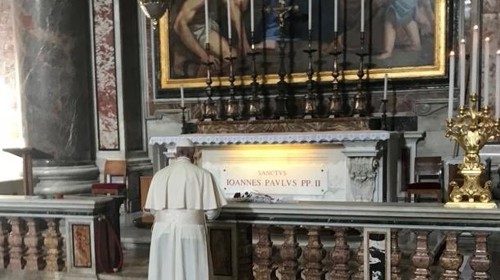
On Monday morning, 18 May, Pope Francis will celebrate Mass at Saint John Paul II’s tomb, for the 100th anniversary of his birth and conclude the broadcast of daily Mass from the chapel in the papal residence.
Next Monday’s 7 AM morning Mass will be the last in a series that has accompanied millions of people throughout the world daily, for over two months. As Masses with people resume in Italy, Francis has in fact decided to stop the live broadcast of his morning Mass. The occasion will be special because 18 May marks the 100th anniversary of Karol Wojtyła’s birth, and for this reason Francis will celebrate Mass at the tomb of his Predecessor, the Pontiff-Saint, who was born in 1920, elected Bishop of Rome in 1978, died in 2005 and was canonized in 2014.
The live broadcast by video, radio and streaming of the celebration of morning Mass at Santa Marta and the decision to celebrate it daily throughout this period of quarantine, was an unexpected and beautiful gift. Many people, even those who are far from the Church, felt accompanied and supported by the Pope who quietly knocked on the doors of their homes at the start of each day. Many discovered the importance and comfort of the daily encounter with the Gospel. Never before had so many people followed weekday liturgies on TV, offered without commentary and with several moments of silent adoration of the Most Holy Sacrament.
The beauty and simplicity of the off-the-cuff homilies delivered by the Pope allowed us to enter the pages of the Gospel, as if we were present when those events took place. During the emergency that has forced us to remain confined within the walls of our houses, the importance of this daily magisterium has been confirmed, and made even more decisive in moments of uncertainty, suffering, anguish, and of so many questions about the future.
The Santa Marta homilies represent a significant aspect of Francis’ service as Bishop of Rome. Many had already been accustomed to following them through the summaries offered by Vatican Media and in the volumes of the Vatican Printing Press, which collects them annually. In the last two months, however, it has been different, because the live broadcasts offered the opportunity to participate, albeit at a distance, in these daily celebrations, watching the Pope as he preaches and comments extemporaneously on Scripture.
Many millions of people entered into contact with these Masses each day. Countless people have written to express their thanks. Now, as celebrations resume with people in Italian churches, a new phase has begun. Many, we can be sure, will miss this daily appointment. But, as Francis himself has said, we need to return to communal familiarity with the Lord in the Sacraments, participating in the Liturgy in person. Let us not forget another invitation from the Pope: that we “visit” the pages of the Gospel every day, with the daily contact to which we have by now grown accustomed through the televised Masses at Santa Marta.
Andrea Tornielli




 Purchase the Encyclical here Fratelli Tutti
Purchase the Encyclical here Fratelli Tutti